A Step-by-Step Guide to Build a Minimum Viable Product (MVP)
Summary: No business wants to spend money on a product only to discover that it has no market. An MVP is the answer to innovative product development. Creating a Minimum Viable Product (MVP) is a popular launch strategy that has worked wonders for big names like Dropbox, Figma, Uber, etc. Rather than rushing to code the next big thing, create an MVP first. Determine your story and then explain what makes it unique. What is the value offered, and what’s the problem you are solving? Here’s a guideline for the step-by-step creation of MVPs.
The year was 1999. A young guy wanting to own a particular pair of shoes went to a nearby shop but was unsuccessful. Frustrated, he came up with an idea to sell shoes online, and that’s where it all started. The concept of a Minimum Viable Product (MVP) was born.
Rather than conducting extensive and expensive market research, he built a basic website. Then, he approached a shoe store, clicked pictures of shoes, and placed them on his site. Upon receiving the order, he purchased the shoes from the store and shipped them out.
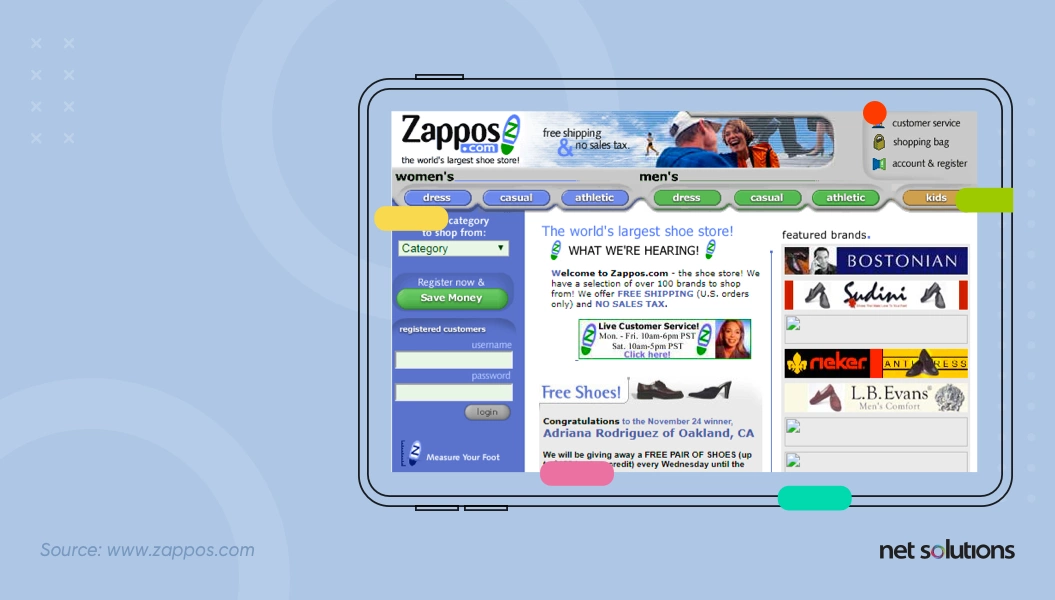
Although he lost money on every sale, it was an incredible way to test a business idea. Once he inferred that customers were willing to purchase shoes online, he started turning his concept into a fully functional business.
This is how Nick Swinmurn built the company Zappos, which Amazon later acquired for USD 1.2 billion.
The approach that Nick followed is now called MVP Development.
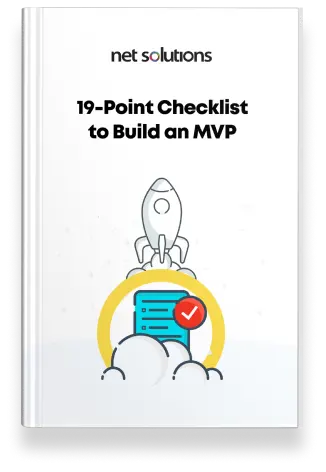
We respect your privacy. Your information is safe.
Mục lục bài viết
What is an MVP (Minimum Viable Product)?
An MVP (Minimum viable product) is a basic, launchable version of the product that supports minimal yet must-have features (which define its value proposition). It is built with the intent to enable faster time to market, attract early adopters, and achieve product-market fit from early on.
The MVP concept is perceived as a combination of the “minimum essentials” – something that has the basic features to satisfy the initial customers. The follow-up involves taking feedback that will help for future product development.
Eric Ries, the man responsible for bringing this concept to the forefront, defined MVP as
The version of a new product which allows a team to collect the maximum amount of validated learning about customers with the least effort.
However, the “least effort” doesn’t mean that an MVP is the “minimum” functionality to be developed. It has to be “viable,” too – implying that, during the design, keep in mind that the MVP must be usable, reliable, and considerate of user needs (empathetic design). This builds the base for taking user feedback to improve for the next iteration and assess whether the product is viable.
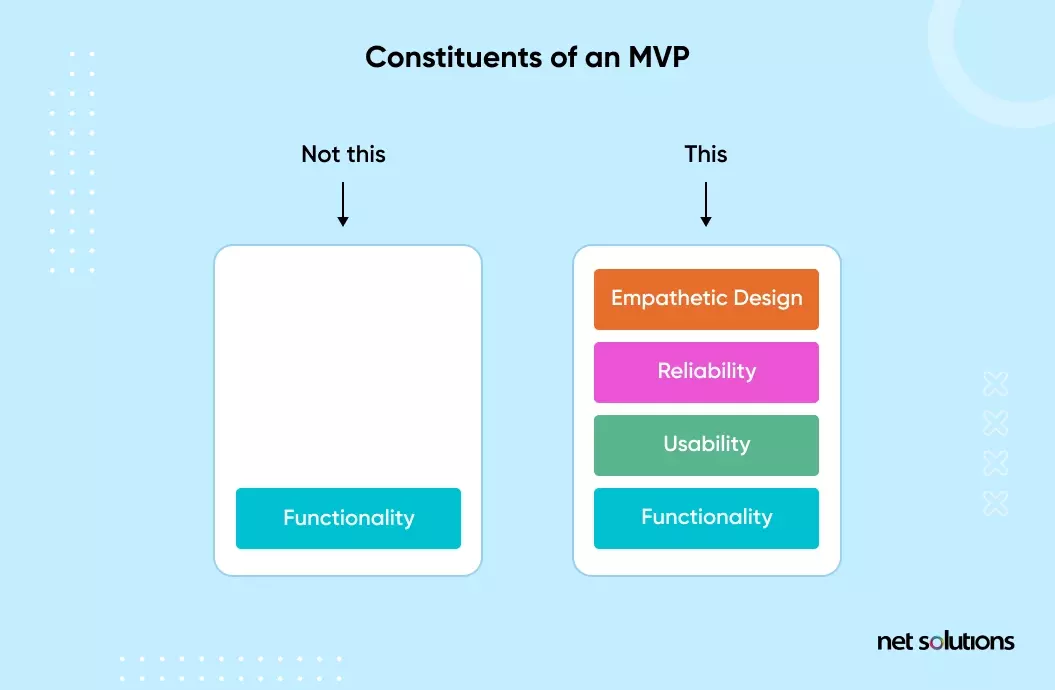
Purpose of an MVP
The purpose of building an MVP is to launch a product quickly, based on an established idea, with a small budget. MVP development solutions allow businesses to collect users’ feedback for the primary product and include it in future iterations. With an MVP, one can find the right audience, pull the ideas based on experience, and save time.
Stats Emphasizing the Need to Build an MVP
- 29% of startups fail because they run out of cash
- Startups that scale properly grow 20 times faster than those that scale prematurely.
These stats explicitly show the benefits of beginning the new product development process with an MVP. However, there are more reasons that a MVP product development company has, to build a Minimum Viable Product:
- Creating an initial model that provides a starting point for discussions and offers clear visual points of reference
- Conducting initial idea approval includes sharing the model with a few prospects and testing it with genuine users. This helps in understanding the issues that may become apparent with the product
- Starting the actual building process after dedicating months to improving and refining the software idea is a significant and motivating step toward building a fully-fledged product.
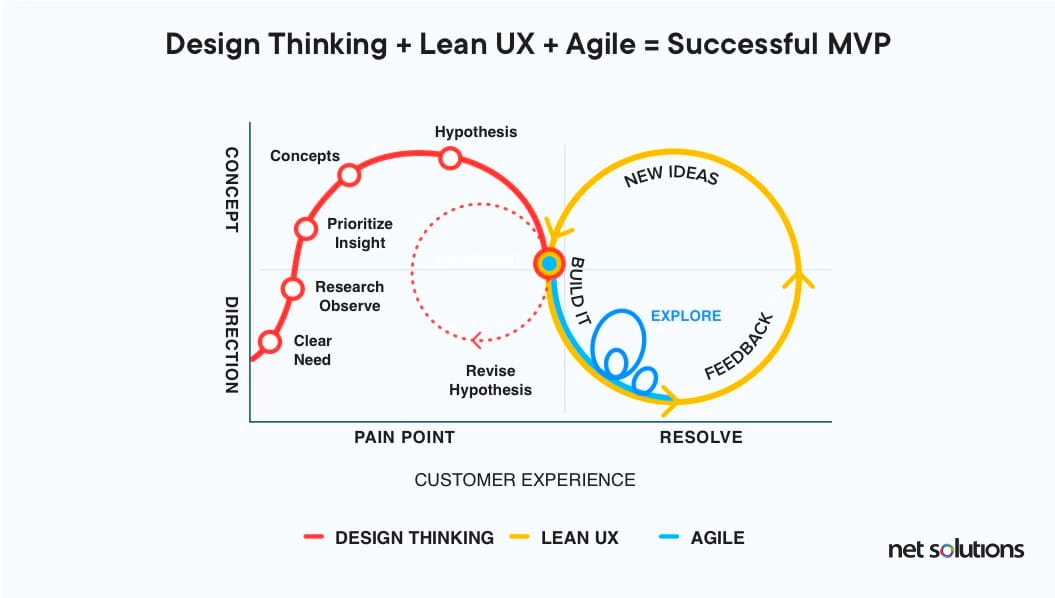
While building a mobile app, a business must understand that the whole idea of building an MVP is divided into two main parts:
- Business and Marketing: An MVP allows the business to launch a survey to identify the best marketing approaches and advertising platforms for the advancement of the product
- Proof of Concept: By building an MVP, the business will gain critical technical insights from necessary programming and designing a minimum feature set, which, in turn, will help them make their app unique
How to Build a Minimum Viable Product?
Queries like “How unpolished can my minimum viable product be?” trend on Quora; Hackernoon writes, “The MVP is Dead. Long Live the RAT.” Google’s autocompleting suggestion says: “MVP is dead.”
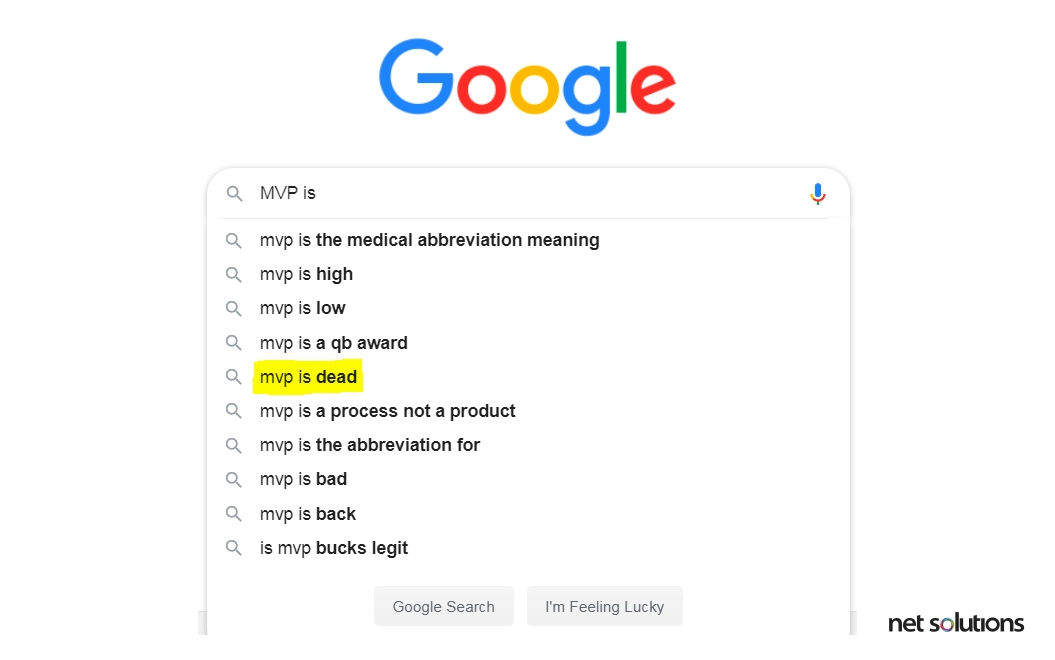
American entrepreneur Reid Hoffman once said that if you are not embarrassed by your first product, you launched too late. However, Hoffman’s words led many startup founders, especially first-time entrepreneurs, to focus mainly on ‘M’ and almost ignore ‘V.’ It resulted in below-average products rather than excellent ones.
For instance, startups develop a free sub-domain website with practically no content and call it a startup. When it fails to attract users, they call it a failed MVP and start looking for a solution to the so-called MVP problem.
The real issue lies in the lack of understanding of the steps involved in MVP development. It is necessary to follow all the steps to build an MVP successfully:
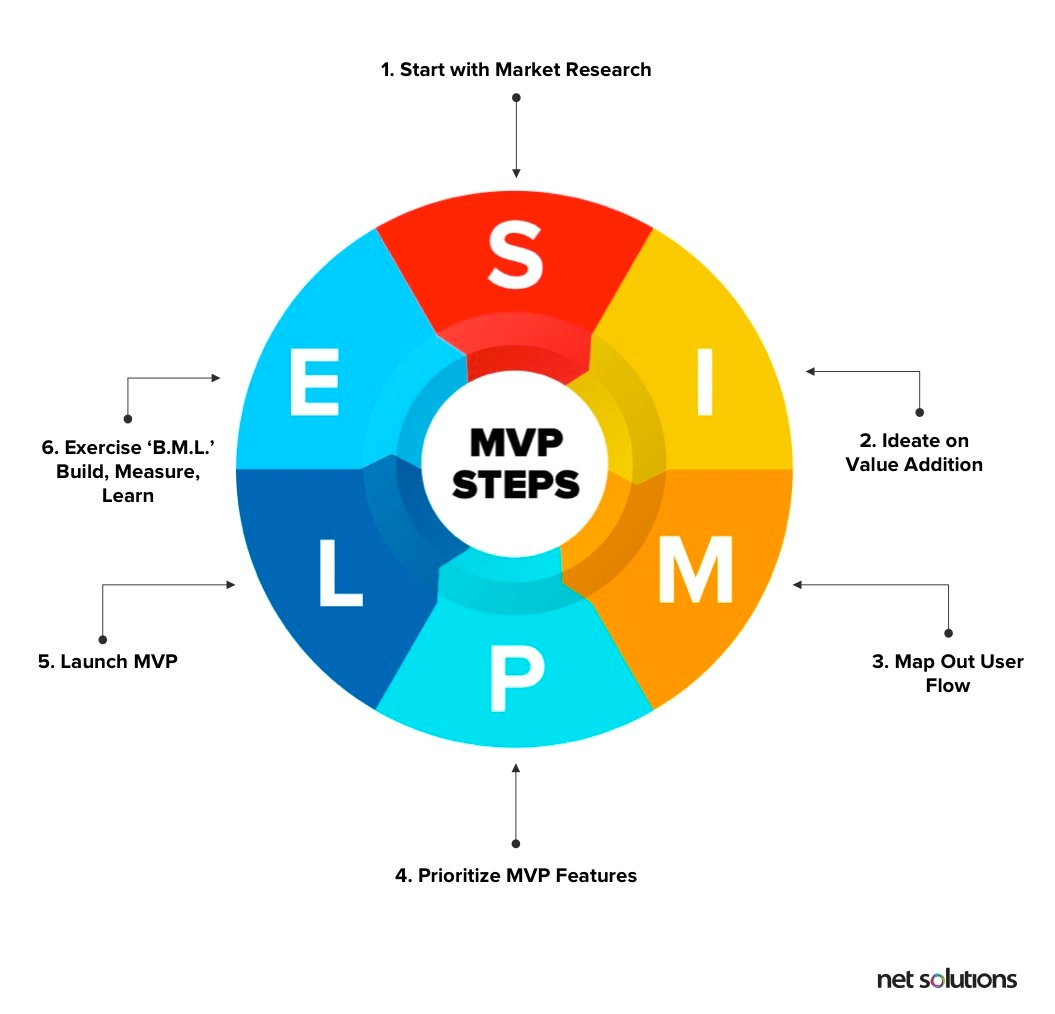
Step 1: Start with Market Research
At times, ideas will not fit the market needs. Before a business initiates an idea and embarks upon an MVP Development process, it should ensure that it fulfills the target users’ needs. Any business would gain by conducting surveys. The more information a business has, the higher the chances of success. Also, do not forget to keep an eye on what the competitors offer and how the product idea can stand out.
It is not enough to do your best; you must know what to do and then do your best. – W. Edwards Deming
A survey conducted by CB Insights revealed that the number one reason for a startup’s failure was a ‘lack of market need.’ If the product doesn’t nail the problem, customers won’t go along with it to find a solution.
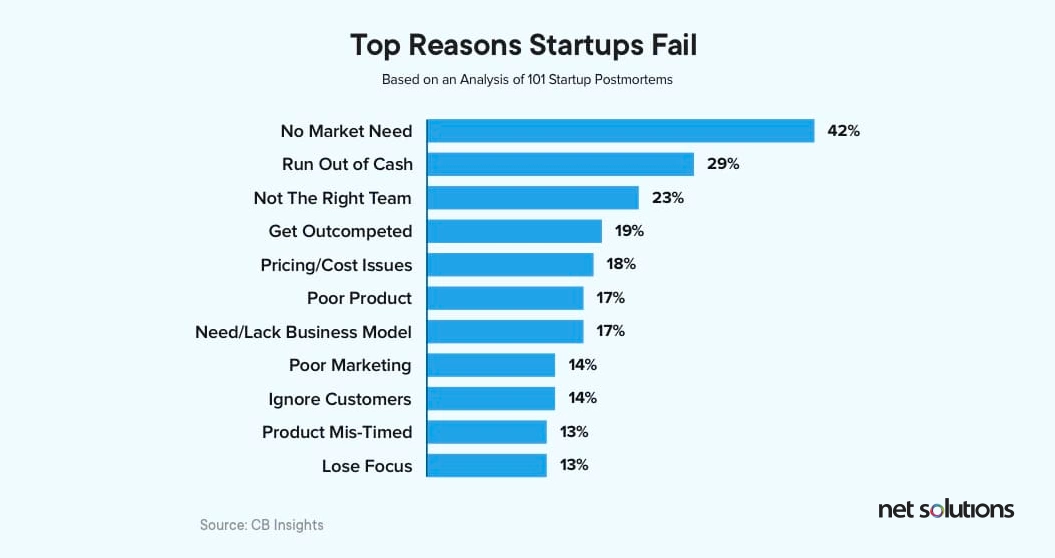
Step 2: Ideate on Value Addition
What value does the new product offer its users? How can it benefit them? Why would they buy the product? The answers to these questions can help define the app’s value proposition.
It should also be clear what the essential estimations are for the product. As MVP implies, the product has to introduce value to the people in its most basic state. Begin by outlining the users and build the MVP based on their needs.
Step 3: Map Out User Flow
The design process is a vital MVP stage. Hence, you must design the app in a way that is convenient for users. The business needs to look at the app from the users’ perspective, starting from opening the app to the final process, such as making a purchase or delivery. In addition, user flow is important because it ensures nothing will be missed while keeping future product and user satisfaction in mind.
Defining the user flow is necessary to determine the process stages. It is essential to explain the steps needed to reach the main objective. The focus should be on basic tasks such as finding and buying the product or managing and receiving orders rather than features.
These are the goals that the end-users will have while using the product. When each of these procedure stages is laid out, it is time to define the features of each step.
Step 4: Prioritize MVP Features
At this stage, prioritize all the features that the MVP will support. To prioritize the MVP features, ask questions such as: What do the users want? Is this product offering them something beneficial?
Next, categorize all the remaining MVP features based on high priority, medium priority, and low priority. Another essential step is to arrange these features in the product backlog (priority-wise). It is time to begin building an MVP. If a business wants to see how its future product will look, it can create an MVP prototype.
Fun Fact: Steve Jobs was out of his job because of avoiding the stage of prototyping while building the Apple Lisa. The result was a disaster as it failed to achieve a good number of sales.
Step 5: Launch MVP
Once a business has decided upon the main features and learned about the market needs, it can create the MVP. Remember that an MVP is not lower quality than a final product but still needs to fulfill the customer’s needs. Therefore, it must be easy to use, engaging, and suitable for the users.
The main reason why products fail is that they don’t meet customers’ needs in a way that is better than other alternatives. – Dan Olsen, author of The Lean Product Playbook
Step 6: Exercise ‘B.M.L.’ — Build, Measure, Learn
Everything is part of a process: first, define the scope of work, then move the product to the development stage. After the product development phase, the product must be tested. The first testing stage is carried out by Quality Assurance engineers who work to improve the product’s quality (even if the product is not yet released).
After launching the MVP, go over everything again. The company must get feedback from its clients on the release. They can determine the acceptance and competitiveness of their goods in the market based on their comments.
5 Development Mistakes to Avoid While Building an MVP
Darwin’s ‘Survival of the Fittest’ theory offers a fitting description in today’s highly competitive digital commerce world. The MVP development process allows business leaders to test their product’s value without spending a lot of money or time.
However, to create a great MVP, you must avoid a few development errors that might lead to a massive business disaster.
1. Choosing the Wrong Problem to Solve
Before spending months of effort on developing a product, the initial step is to determine whether the product is worth creating or not. Once a business has analyzed the pain on which they will build their start-up, they should ask themselves these questions:
- Who is this for?
- What problem will this product solve?
- Is the proposed idea an effective solution to that problem?
If they intend to target everyone, they will get no one. Find the doors first, then start to build the key. A great-looking key is not helpful if it can’t open the right door. After cracking the right target audience, if the answer to the second question is positive and a confident ‘Yes’ for the third, the business has the problem and solution juxtaposed effectively, and it’s time to start pressure-testing their idea.
2. Skipping the Prototype Phase
Imagine building a car without referring to a visual model. It is quite impossible, right? Jumping straightway to the development process without defining the requirements is tricky.
A vital part of product development is evolving the idea from a unique concept to a fully working product or service. Between the idea and the full-fledged product lies the prototype that focuses on the ‘How’ part of the product.
Consider prototyping as an MVP to build an MVP: not a fully functional version, but a version to help visualize the user experience of the Minimum viable product.
The ideal prototype should be of Goldilocks quality. If the quality is too low, people won’t believe the prototype is an authentic product. If the quality is too high, you’ll work all night and won’t finish. You need Goldilocks quality. Not too high, not too low, but just right. – Daniel Burka, Google Ventures Design Partner
3. Targeting the Wrong Segment of Persona
The main reason why products fail is that they don’t meet customers’ needs in a way that is better than other alternatives. – Dan Olsen, author of The Lean Product Playbook
Once a business is ready with an MVP prototype, it’s time to validate it through testing. At this stage, it is necessary to acquire comments and feedback from the target audience. It is essential to remember that everyone is not the targeted user. Do not ask friends or relatives to be involved in this stage unless they are potential customers. It is essential to avoid irrelevant feedback that could lead to the product/service getting dumped for the wrong reasons.
The Importance of Feedback in Building an MVP
It is essential to realize that the end-users are the ones who can tell what is lacking and what is redundant. Once a business collects user feedback, it can start improving the product. Once improvements have been made, they will once again test, learn, and measure the quality. This process repeats until the product is finalized.
Example: Nike learned from potential consumers’ comments after the prototyping stage that it’s difficult for them to find the call to action (CTA). They could avoid delivering a difficult product for users to engage with because of the input they received during prototyping.

4. Inappropriate Development Method
There’s a way to do it; better find it. – Thomas A. Edison
One of the most common causes for companies abandoning projects in the middle is jumping right into the MVP development process without knowing the proper development method. One of the significant reasons why nine out of 10 startups fail is this. In general, Agile and waterfall techniques for MVP product development are used.
Generally, there are two approaches for MVP product development: Agile and waterfall.
Compared to Waterfall (Traditional Method), Agile product development is more efficient and offers better results. Agile offers speed to market and a flexible approach as it focuses on incremental and iterative development.
5. Confusion Between Qualitative and Quantitative Feedback
Qualitative and Quantitative feedback are two ways to collect data from the target users. However, relying on one and neglecting the other can hinder the business’s reaching an accurate conclusion.
Both types of feedback have different roles, so it is vital to hit the right balance between them to come to a well-rounded conclusion that can help inform intelligent changes.
- Qualitative feedback consists of findings associated with the quality and user-friendliness of the features of the product/service. It directly assesses the usability of the system by helping developers to analyze the specific problematic UI elements.
- Quantitative feedback is in the form of metrics that pinpoint whether the tasks were easy or difficult to perform. It indirectly assesses the usability of the design. Such feedback can depend upon the user’s performance on a given task (i.e., success rates, number of errors, etc.)
Concern
Qualitative Feedback
Quantitative Feedback
1. Questions answered
Why?
How many and how much?
2. Goals
Both formative and summative:
Inform design decisions
Identify usability issues and find solutions for them
Mostly summative:
Evaluate the usability of an existing site
Track usability over time
Compare the site with competitors
Compute ROI
3. When it is used
Anytime: during the redesign, or when you have a final working product
When you have a working product (either at the beginning or end of a design cycle)
4. Outcome
Findings based on the researcher’s impressions, interpretations, and prior knowledge
Statistically meaningful results that are likely to be replicated in a different study
The ideal approach would be the amalgamation of qualitative feedback with quantitative feedback. This is known as “Triangulation Feedback” and describes the process of gathering data for an overall accurate interpretation that considers various factors.
This approach boosts the chances of controlling the threats resulting in product failure. If both the feedback methods come to a common conclusion, the developer will be more confident in the product’s success.
Tips to Target the Right Market while Building an MVP
Beautiful product development in an ugly market segment simply makes no sense. – Dan Adams
Imagine how to sell a minimum viable product of an air conditioner in Antarctica. This is a challenging task. The same rule applies when a business is on a mission to build an MVP. No matter how good the product/service is, it will fail if the business cannot solve the other half of the equation: finding the ideal target market for the MVP.
Most startups begin to build an MVP with a sweet assumption that “everyone” will rush to buy their products or sign up for their services. Soon, they become one of the references for various studies and research. For example, this report from HBR reveals that 85% of 30,000 new product launches failed because of poor market segmentation.
1. Analyze the Competition
It is important to dive deep into the competitor research to determine what the product will be up against. It’s nearly impossible to build an MVP that doesn’t already exist in the market. Even if a startup has unique ideas, it will still be joining an existing and competitive industry.
Therefore, they have to figure out how to place their Minimum Viable Product within an industry where competitors are doing what they are trying to do.
To find this out, the startup will need to research the competitors. Evaluate their strong points and weaknesses. Figure out their target audience and what they are offering to them. The startup can go ahead with the same target market their competitors chose, or they can concentrate on a group that their competitors might have overlooked.
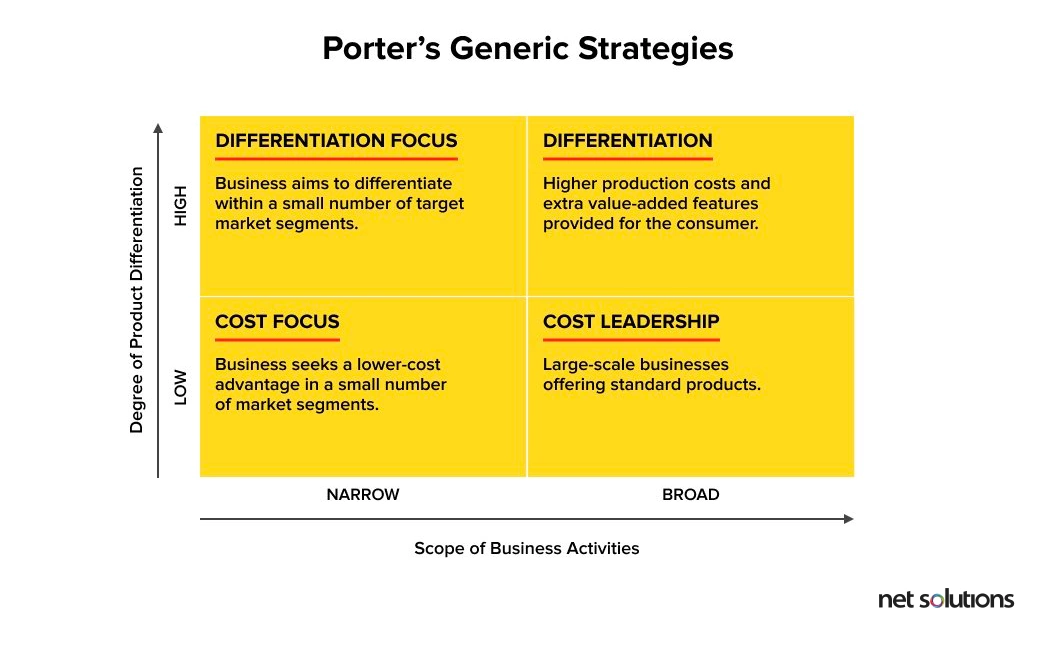
Look at the image above as a reference. There are 4 basic options for any startup to successfully compete in a given industry: cost leadership, differentiation, cost focus, and differentiation focus.
2. Geographically Segment the Customer Base
Once the startup has found the right customer base for the MVP, the next task is to focus on geographical segmentation. This is an effective strategy used by businesses to get familiarized with the location-based attributes that comprise a specific target market. Analyzing the location of the ideal customer base can be a real game-changer while on the route to building an MVP.
For instance, what’s the purpose of initiating the search from Southern California if the minimum viable product is a winter jacket. The winter varies from moderate to warm in this place.
Target consumers in different geographic regions have different needs and cultural characteristics that can be individually targeted for better and more efficient marketing. Once the startup becomes aware of the geographical location of the target customer, they can better design their MVP by finding answers to key questions such as these-
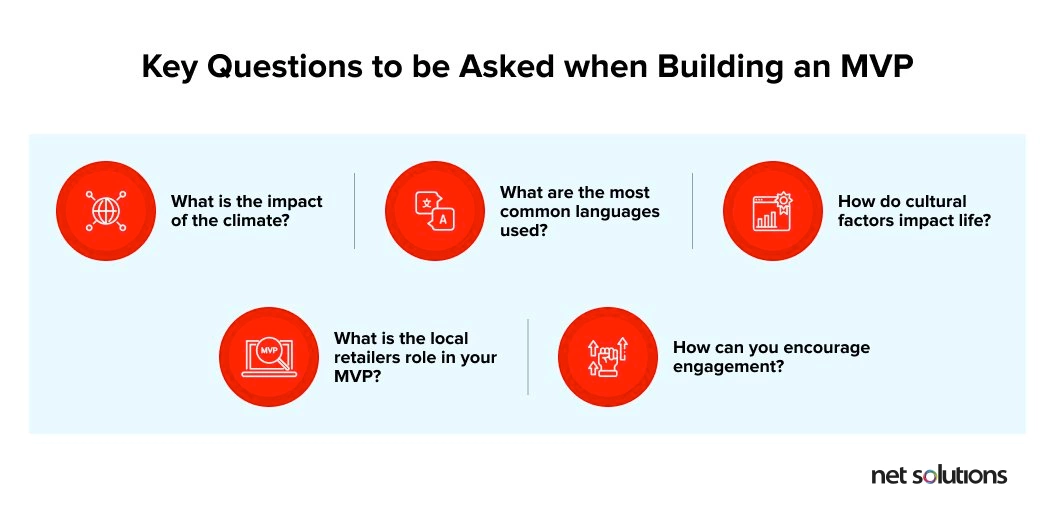
It is evident from the picture above that there are various factors dependent upon geographical location, which play a vital role in the success of an MVP and product development.
3. Find the Motivation Behind a Purchase
After geographically segmenting the customer base, the next task is to understand their motivation behind the purchase. This will help the startup perfectly balance its MVP positioning.
The easiest way to achieve this is to run a survey. Keeping the Minimum Viable Product in mind, come up with relevant questions that circle the points discussed above. Once ready with a survey, it can be run in several ways depending upon the budget.
Measuring Success After Building an MVP
There are several approaches to predict a product’s future success accurately. Here are the most common, effective, and proven ways to measure the success of an MVP:
1. Word of Mouth
Traffic is a valuable metric to predict success. Another way to track success is by interviewing potential customers. Begin by listing the problems a customer is facing or is likely to face, and then ask what they think.
2. Engagement
Engagement enables a startup to measure not only the current value of the product but also the future value. Engagement helps to improve the user experience based on feedback.
3. Sign-Up
Sign-ups are a feasible way to gauge user interest. They may also convert to revenue based on measuring interest in the product.
4. Better Client Appraisals Based on the Feedback
The number of downloads and launch rates shows users’ interest in the app. The lighter the app is, the more downloads it will get.
5. Percentage of active users
Download and launch rates are not the only factors that measure the success of an MVP. It is essential to study users’ behavior and regularly check the ratings of active users.
6. Client Acquisition Cost (CAC)
It is imperative to know how much it costs to acquire a paying customer. This helps a startup stay updated on whether their marketing efforts are effective or if they require changes.
CAC = Money spent on traction channel / Number of customers acquired through the channel.
7. Number of Paying Users
Know the average revenue per user (ARPU) and keep track of products that bring revenue.
ARPU = Total income for the day and age/Number of active users
8. Client Lifetime Value (CLV)
CLV demonstrates how much time a user spends on the app before uninstalling or discontinuing their app use.
CLV = (Profit from a user *App usage duration) – Acquisition cost
9. Churn Rate
Churn shows the level or percentage of people who have uninstalled or stopped using the app.
Churn = Number of churns per week or month / Number of users at the beginning of the week or month.
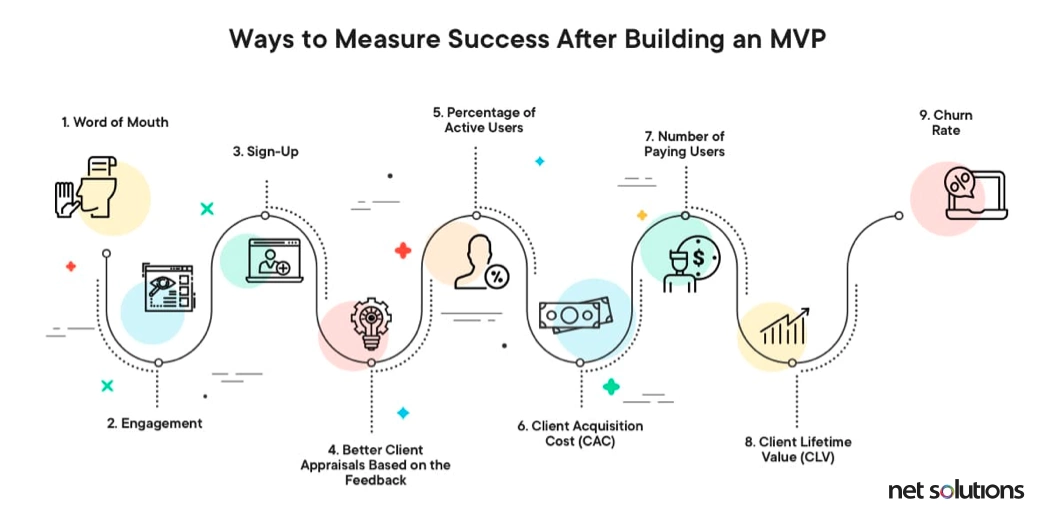
Frequently Asked Questions
1. What should a Minimum Viable Product (MVP) include?
A minimum viable product, or MVP, is a product that has enough features to encourage early adopters and substantiate a product idea beginning of the development cycle. In industries such as software, the MVP can assist the product team in receiving user feedback as quickly as possible so that the product can be iterated and improved.
2. How do I prepare for an MVP for my product?
You can start your MVP journey with these steps –
- A thorough market research
- What value does your product offers
- Algin your user flow
- Prioritize features that help your audience
3. What is the difference between a prototype and a Minimum Viable Product?
A prototype is a quick way to test the product’s fundamental ideas and assumptions. On the other hand, an MVP is a usable version of the product that contains only the core features. It is ideal for testing, resulting in feedback and valuable data, but with the least amount of time and money invested at this stage.
4. How long should it take to build an MVP?
Building an MVP purely depends on the feature set, design complexity, and human resources involved in the process, typically around 3-5 months.











